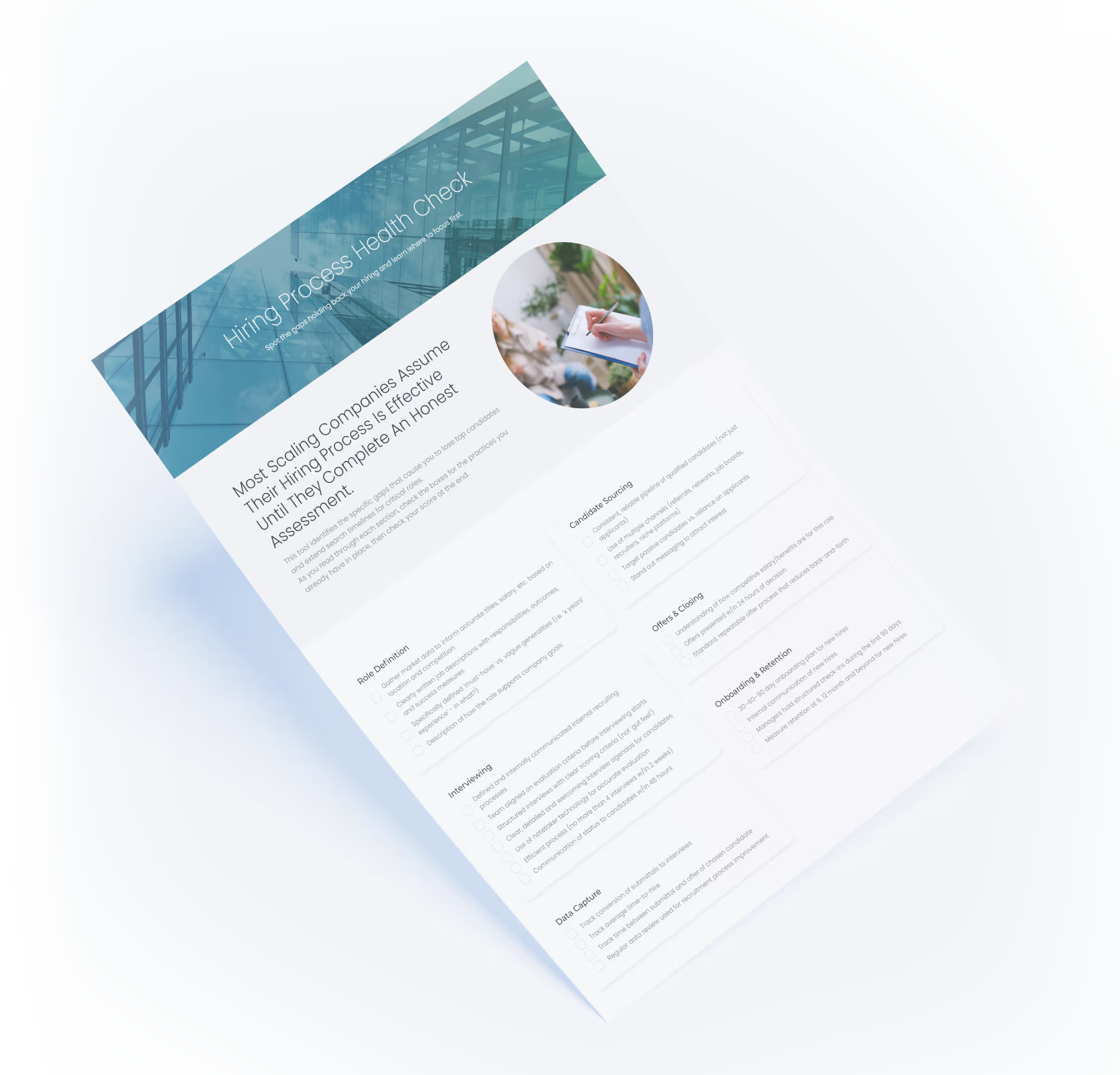Avoiding Bad Hires: How to Spot Warning Signs Early

A bad hire doesn’t just cost you money. It costs you momentum, trust, and time you’ll never get back. The wrong person in the wrong seat can set your team back months. And if you’re scaling fast, trying to fill roles, and don’t have a full-blown talent acquisition team in-house, you’re even more vulnerable.
Here’s what we know after years of partnering with fast-growing companies: most hiring mistakes are preventable. If you're paying attention, the red flags are there. But the problem is, when you're overwhelmed, under-resourced, and facing pressure to “just fill the role,” it’s easy to miss the warning signs of a bad hire.
Discover how you can build sharper instincts, identify misalignment early, and strengthen your hiring process so you don’t end up with another “how did this person get past us?” situation.
The True Cost of a Bad Hire (And Why It Hurts More Than You Think)
We’re not being dramatic when we say that bad hires kill momentum.
According to Gallup, the cost of replacing an employee can range from 40% to 200% of their salary. That includes onboarding, lost productivity, lost opportunity, and the ripple effect on your team.
It also costs something less tangible: your credibility as a leader. When you bring in someone who’s clearly not a fit, your team starts to question your judgment. They wonder if you see what they see. That erodes trust fast.
And let’s be real: in high-growth environments, you don’t get unlimited do-overs.
Spot the Warning Signs of a Bad Hire Before You Make an Offer
1. The resume is all flash, no substance.
Buzzwords are cheap.
If a resume is loaded with jargon like “change agent,” “strategic thinker,” or “growth-oriented leader” but can’t back it up with outcomes, it’s noise.
Look for real results. Numbers. Tangible wins. If their resume looks like they’re trying to impress rather than inform, dig deeper.
Also watch out for:
- Frequent job hopping without clear progression or explanation
- Inflated titles that don’t make sense for the company or the stage they were at
- Gaps in employment that are vaguely addressed or ignored
Resumes tell stories. If the plot doesn’t add up, there’s usually a reason.
2. The interview feels off, even if they check the boxes.
Want to know how to avoid hiring bad employees? Start by paying closer attention during interviews. Candidates can prep answers or rehearse STAR stories, but they can’t fake alignment.
Watch for these yellow-to-red flags:
- They give surface-level answers with zero follow-up questions.
- They seem more interested in selling themselves than understanding you.
- When asked about failure or feedback, they blame others or dodge accountability.
- They don’t seem curious about the product, the team, or the mission.
Hiring isn’t just about who can do the job but also about who wants to do it here with your team under your mission.
3. Their values don’t match yours.
Here’s where most hiring mistakes happen. You hire someone with the right skills but the wrong mindset.
If someone thrives in a corporate structure and you’re scrappy and startup-fast? Misalignment.
If you value autonomy and ownership but they need constant direction? Misalignment.
If they don’t light up when you talk about your mission or your big, wild goals? Huge red flag.
Culture fit is overused and often misapplied, but value alignment is critical. Skills can be coached. Mindset can’t.
4. They’re focused on what they get, not what they give.
Look, everyone wants good pay and flexibility. But if a candidate is hyper-focused on the perks and hasn’t asked a single question about the role’s purpose, impact, or expectations, then they're not in it for the right reasons.
You need people who are excited to contribute, not just looking for their next comfortable landing pad.
5. They don’t know much about your company.
If a candidate shows up without doing basic research, that’s a signal. You’re hiring someone to join a mission-critical team, not just fill a role. Taking time to understand your mission, product, and values is non-negotiable, and ignoring that step is a clear obstacle to avoiding bad hires. If they haven’t done the homework now, they likely won’t go the extra mile once they’re in.
Trust Your Gut, But Don’t Rely Only on It
If something feels “off,” and you’re forcing yourself to overlook it because “we really need someone,” pause. That’s your instincts waving a giant red flag. The pressure to fill the seat can’t outweigh the risk of getting it wrong.
But gut checks alone aren’t enough.
They’re most powerful when paired with a structured, intentional process.
Build a Hiring Process That Filters for Fit
Even if you don’t have a full internal TA team, you can level up your process with a few key moves to figure out how to avoid hiring bad employees:
- Define the role with ruthless clarity. If you don’t know exactly what success looks like, how can the candidate prove they’re right for it?
- Ask values-based questions. “Tell me about a time you disagreed with leadership.” “What’s something you failed at recently, and what did you learn?” Listen to how they think, not just what they did.
- Loop in the right team members. Cross-functional interviews give you a fuller picture and help catch blind spots.
- Use test projects or trial periods. When possible, give them a real (paid) task. You’ll learn more in one working session than in five interviews.
- Debrief like it matters — because it does. Don’t skip the post-interview conversation. If anyone’s unsure, talk it out. Misalignment usually reveals itself here.
Partner with People Who Get It
Most external recruiters don’t get your business. They toss you resumes. They talk a big game. But they don’t dig deep enough to understand what great looks like for you.
That’s why we don’t call ourselves an agency. We’re your recruiting partner, and we take that seriously.
At Inside Talent, we work with fast-scaling teams who don’t have time to waste. We act like an extension of your team. We get inside your world, your culture, and your goals and bring you candidates who are aligned and ready to deliver.
Bottom Line: You Can’t Afford a Bad Fit, So Learn How to Avoid Mis-Hires
Hiring is high-stakes. But it doesn’t have to be high-risk.
With sharper instincts, a tighter process, and the right partner, you can stop reacting and start hiring proactively with confidence.
Let’s make sure your next hire is the right one.
Talk to us today about building a smarter, faster hiring process that actually works.
Get Your FREE Hiring Process Health Checklist

